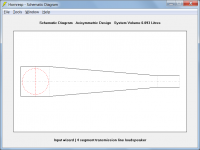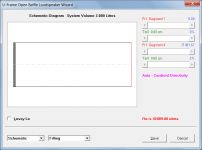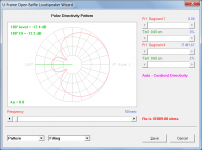?? Transient response is a function of bandwidth. By definition, if a driver is capable of moving quickly enough to reproduce 5KHz in its mass controlled & TL bandwidth, it can move quickly enough in the longer / lower (i.e. slower) frequencies, with those below the mass corner being a function of the chosen combined system alignment characteristics. Do you mean dynamic range? If so: sure, you can't beat cubic capacity. 😉
Last edited:
My hunch is the latter & add +1, here. If I hadn't taken a shine to large symphonic works, I might still be listening to pipes with speedy little widerangers and ribbons. Never stayed with it to find the line for magic woofer size for "enough scale" like a lot of other lifers. Big arrays excepted, there's a point of no return if a person likes 100-piece orchestras and all that, and that's my sense of what they're driving at. Good thread.
I have never heard a small cone play the middle and upper bass of an orchestra well. Even when good bass extension is achieved, small drivers still generally sound thin to me.
Well, in doing some reverse engineering based on the W.E. 755A 3 way single driver's supposedly acoustically optimum design as a guide way back when and accepting the pioneers concluding that fully half of an orchestra's acoustic power is below 500 Hz + assuming (Altec's) 15" effective dia. = ~12.76", then in theory we need ~(32*500)^0.5 = 126.5 Hz mean or a ~13543/pi/126.5 = ~34.08" effective dia. subwoofer.Never stayed with it to find the line for magic woofer size for "enough scale"
(34.08/12.76)^2 = 7.133x/(8) 15" subwoofers or sufficiently sized horn and if we add in a low B pipe, then ideally need 2x more for tonally balanced and of course we can reduce quantity due to low distortion max power handling (presume Xmax/2), any room/boundary gain, so highest SQ/power handling driver, corner loaded in an acoustically small room is least subwoofer size and/or count one can do.
Yes, that causes a pretty big suck-out at 5,000hz which leads me to believe I got the timing setback, maybe not perfect, but pretty close.
Yeah, this doc's 6-8 dB has worked fine for me.
Attachments
Indeed, use the math I just posted to find at least my minimum ideally required.I have never heard a small cone play the middle and upper bass of an orchestra well. Even when good bass extension is achieved, small drivers still generally sound thin to me.
“The impulse response and step response are transient responses to a specific input (an impulse and a step, respectively).” That can be bandwidth, waterfall, but usually it‘s a very short sample to see if the system rings.?? Transient response is a function of bandwidth. By definition, if a driver is capable of moving quickly enough to reproduce 5KHz in its mass controlled & TL bandwidth, it can move quickly enough in the longer / lower (i.e. slower) frequencies, with those below the mass corner being a function of the chosen combined system alignment characteristics. Do you mean dynamic range? If so: sure, you can't beat cubic capacity. 😉
So small woofers appear to me as polite tympani, soft pizzicato in the cellos and basses. The smooth frequencies like the early pedal tones in Saint Sanz 3rd are there, strong, and room shaking. Later in the symphony when the basses come in they seem less aggressive than if played by 12” woofers. On the other hand, my econowaves with 12” woofers get the growl and impact but don’t play the pedal tones well.
See if I can state this more clearly. 🤔 I think certain parts of the musical spectrum require a certain size woofer to present a good realistic image of the recording. T-lines produce those frequencies but seem to lack impact in the lower mid bass region, I believe, due to the relatively small cone size. This effect can be minimized by placing the speaker in an appropriate sized, smaller, room.
Yes. For the purposes of the simulation the slot port is treated as a cylinder of equivalent cross-sectional area.I mean, does HR simulate <1 tapered ML-TL where the ML is a slot (possibly resistive Onken)?
Like this design schematic:
https://www.diyaudio.com/community/...ir-5-2-in-evansound-3-75l.393909/post-7260419
(The attachment below is not to scale).
Attachments
Actually, you could build a TL for 12" or 15" drivers... they just get... big!T-lines produce those frequencies but seem to lack impact in the lower mid bass region, I believe, due to the relatively small cone size
Most people do not have the space in their living room for such a sizable TL.
I'm afraid I still don't follow. An acoustic transmission line is simply a broad range of enclosure types that either uses quarter-wave resonance to support the LF, or at the other end of its spectrum of possible options, a heavily damped pipe to suppress the output and provide the flattest possible impedance load to the amplifier. It is unconnected to driver size and there no reason whatsoever why you cannot design them for any size drive unit you feel so inclined for, just as you can with any other enclosure type.See if I can state this more clearly. 🤔 I think certain parts of the musical spectrum require a certain size woofer to present a good realistic image of the recording. T-lines produce those frequencies but seem to lack impact in the lower mid bass region, I believe, due to the relatively small cone size. This effect can be minimized by placing the speaker in an appropriate sized, smaller, room.
So filling is required to mimic the slot's acoustic resistance.Yes. For the purposes of the simulation the slot port is treated as a cylinder of equivalent cross-sectional area.
'Preaching to the choir'! 😉 'so sayth the pioneers', so use their math I posted to find the 'sweet spot' size for a given BW.I think certain parts of the musical spectrum require a certain size woofer to present a good realistic image of the recording.
In my queue is a mere 45L ~1.7m TLonken conversion for 15" widerange + axial supertweeter (need to jigsaw the holes aack). Given a folded very-high-taper line, the quarterwave frequency might end up lower than I want. Unlike >1 expanding BLH or 1:1 TL, the <1 tapered TL gains substantial effective length (as Dave often pointed out).Actually, you could build a TL for 12" or 15" drivers... they just get... big!
Most people do not have the space in their living room for such a sizable TL.
Dubbed "Axia", the 15" driver's butt goes through a many-holed well-stuffed aperiodic washbasin then into a 6.5" speaker cutout serving as holder -- my (current) micro-15 desktop speakers.
But even a 5.5" 10L 1.3m TLonken can have astonishing, exhilarating bass drum roll in Dvorak 9th.
Last edited:
I had a TLS with the same geometry and bass driver as IMF TLS80. Flat output down to 18-20 Hz. But the single 10" drive unit could not bring the bass slam of 15" driver.I tend to agree that there is a correlation of bass and size of bass driver for any given room. 8" driver might be good for a given room but for a room wiith double the dimentions, the fundamental frequency drops by a factor of 2 and that in it self increase the needed cone motion by a factor of 4. And added to this the volume of the room is increased by 8. This combination might be to much for a 8" driver...
So filling is required to mimic the slot's acoustic resistance.
Hi GM,
There seems to be a generally-accepted theory that the multiple rectangular port slots in the Onken bass reflex design are resistive. From the examples I have seen the dimensions are such that I am not so sure that is the case.
A rectangular slot port tube and a cylindrical port tube both act primarily as acoustical inductances. The radiation impedances at the outputs will be a little different, but unless the slot has an unrealistically high aspect ratio, the two port tubes should perform in much the same way if they have the same lengths and overall cross-sectional areas.
Acoustical resistance to attenuate port output can be introduced by placing a fine-mesh screen across the outlet. In Hornresp, the mesh screen can be modelled by specifying a thin sheet of absorbent filling material having a relatively high airflow resistivity value, as demonstrated in the attached example.
Kind regards,
David
Attachments
There seems to be a generally-accepted theory that the multiple rectangular port slots in the Onken bass reflex design are resistive. From the examples I have seen the dimensions are such that I am not so sure that is the case
Given the size there is likely little, but the long part migh cause some higher frequency issues. The much narrower slots on my miniOnkens (borrows the slpt vent arrangement but a quite different alignment), do provide some. They can be furthe pushed aperiodic by inserting open cel foam into the vents.
dave
The TABAQ 1:1 TL, slot-port ML, is it well-modelled by HR without adding resistive component? Thanks again.
For the purposes of the simulation I see no point in adding a resistive component to the port. The transmission line itself will of course require absorbent filling material to be specified.
Out of interest I went looking for information on the TABAQ design and came across the audioXpress article linked below:
https://audioxpress.com/article/TABAQ-Tang-Band-Quarter-Wave
The following statement taken from the article is interesting:
"TABAQ uses the mass loading principle, in which the last part of the pipe has a smaller area than the rest of the pipe. The air in this part of the pipe adds resistance to the driver (more mass-mass loading)."
The second sentence is not strictly correct. The air in the pipe acts as an acoustic mass which adds inductive reactance to the system, not resistance. Perhaps the use of the word resistance is what is confusing some people about the nature and purpose of the port.
Out of interest I went looking for information on the TABAQ design and came across the audioXpress article linked below:
https://audioxpress.com/article/TABAQ-Tang-Band-Quarter-Wave
The following statement taken from the article is interesting:
"TABAQ uses the mass loading principle, in which the last part of the pipe has a smaller area than the rest of the pipe. The air in this part of the pipe adds resistance to the driver (more mass-mass loading)."
The second sentence is not strictly correct. The air in the pipe acts as an acoustic mass which adds inductive reactance to the system, not resistance. Perhaps the use of the word resistance is what is confusing some people about the nature and purpose of the port.
Last edited:
- Home
- Loudspeakers
- Full Range
- Transmission line speakers


